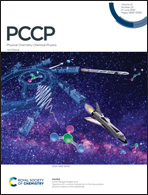Adsorption of CO2 and CH4 in MIL-47 investigated by the 3D-RISM molecular theory of solvation
Abstract
Metal–organic frameworks (MOFs) comprise a class of highly porous nanomaterials formed by the assembly of organic molecular templates connected by metal ions. These materials exhibit a large diversity of pore size and geometry, topology, surface area, and chemical functionality. MOFs are particularly promising materials for developing new technologies for capture and storage of greenhouse gases such as methane and carbon dioxide. Here we apply the three dimensional reference interaction site model (3D-RISM) molecular theory of solvation to study the interactions of CO2 and CH4 with the metal–organic material MIL-47. The 3D-RISM integral equations were solved to determine the three dimensional density correlation functions of the gas (solvent) relative to the atomic positions of the MIL-47 framework, treated as static solute sites. The computed solvent spatial distributions inside MIL-47 pores were used to identify whether or not there exist preferable binding sites and the binding free energy landscape for the gas of interest at low computational costs compared with other molecular modeling techniques, such as grand canonical Monte Carlo and molecular dynamics simulations. The 3D-RISM formalism was applied to pure CO2, pure CH4, and binary mixtures of these gases of various compositions under different pressure conditions. The results indicate that both gases bind very weakly to MIL-47 and that this material exhibits nearly vanishing CO2/CH4 selectivity. The 3D-RISM computations presented here can be extended to investigate the physical adsorption of gases on other MOFs and nanoporous materials, providing an alternative low-cost computational approach to study gas capture and storage in nanoporous materials in general and, in particular, to determine the binding free-energy landscape in these systems.



 Please wait while we load your content...
Please wait while we load your content...